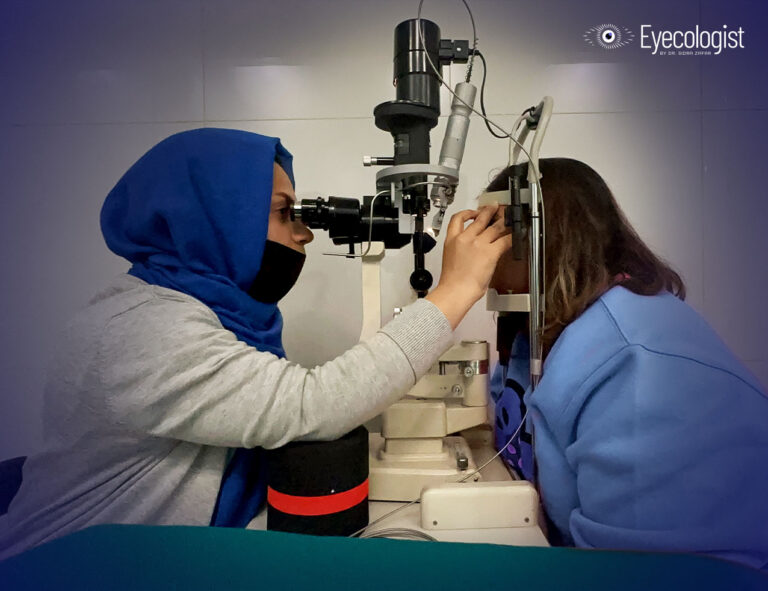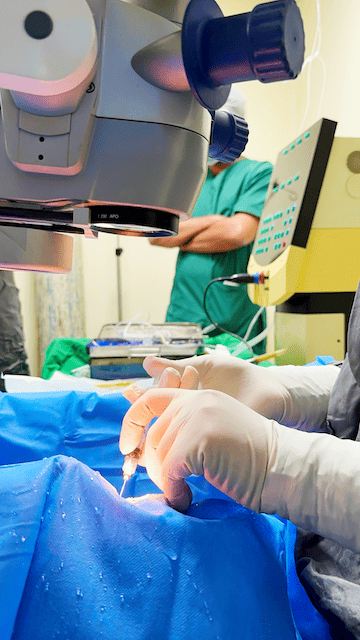Gentle Technology, Powerful Results
What is Eye Laser (YAG/Argon)?
Eye laser procedures are modern, outpatient treatments designed for safety, precision, and convenience. Done within the OPD, they usually take about two hours, with no hospital admission required. While temporary blurred vision for a few hours is expected, most patients return home the same day and resume normal activities soon after. A follow-up visit is scheduled around one month later to monitor results.
Types of Laser Treatments:
- YAG Laser: Commonly used for treating posterior capsular opacification (secondary cataract) after cataract surgery. It may also be applied in some glaucoma treatments.
- Argon Laser: Widely used for diabetic eye disease, this treatment helps prevent further progression and preserves both central and color vision.
With eye laser treatment, patients can expect a safe, effective, and quick solution for restoring and maintaining clear vision.
Causes for Eye Laser Treatment (Why It’s Needed)
Eye laser treatment is often recommended to manage and protect vision in specific eye conditions. These procedures are safe, quick, and highly effective when performed at the right stage of disease. Common conditions treated with lasers include:
- Posterior Capsular Opacification (Secondary Cataract): Clouding that occurs after cataract surgery, treated quickly and painlessly with a YAG laser.
- Glaucoma: YAG laser helps improve fluid drainage, lowering eye pressure to prevent further vision loss.
- Diabetic Retinopathy: Argon laser seals leaking blood vessels, slowing disease progression and preserving central vision.
- Retinal Tears or Holes: Argon laser creates scar tissue to close retinal breaks, reducing the risk of retinal detachment.
Laser treatment offers targeted care, helping preserve vision and prevent complications with minimal downtime.
Symptoms Indicating the Need for Eye Laser
Eye lasers (YAG or Argon) are often advised when common eye conditions begin to affect vision or quality of life. Signs you may need treatment include:
- Blurred or cloudy vision after cataract surgery, known as secondary cataract.
- Increased sensitivity to light, glare, or halos.
- Visual distortion or loss from diabetic retinopathy.
- Sudden appearance of floaters, flashes, or dark spots, possible signs of retinal tears.
- Elevated eye pressure or glaucoma-related changes.
These symptoms should never be ignored. Laser treatment is a proven, safe, and minimally invasive solution that helps stabilize your eyesight and reduce the risk of long-term vision loss.

Risk Factors Related to Eye Laser Treatment
Eye laser procedures are safe, effective, and widely performed, but like any medical treatment, a few considerations should be kept in mind. Most patients recover quickly with minimal discomfort, but temporary side effects may occur, such as:
- Blurred vision for a few hours after treatment.
- Mild irritation, redness, or discomfort in some cases.
- Rare risks, such as slight increase in eye pressure, Inflammation inside the eye, and retinal swelling or bleeding (very uncommon).
To ensure the best outcomes, regular follow-up visits are essential. These visits allow your doctor to monitor healing, address any concerns, and confirm that the treatment has been successful in protecting your vision.
Sometimes, the smallest laser touch can bring back the biggest gift… clear sight.
Sometimes, the smallest laser touch can bring back the biggest gift… clear sight.
Frequently Asked Questions about Eye Laser (YAG / Argon)
Q1. Is eye laser treatment painful?
No. The procedure is quick and painless. Numbing eye drops are used, so you may only feel mild pressure or slight discomfort, but no pain.
Q2. How long does the procedure take?
The entire process, including preparation, takes about 1–2 hours. The laser treatment itself usually lasts only a few minutes.
Q3. How soon will my vision improve?
Many patients notice clearer vision within a day, especially after YAG laser for secondary cataracts. In cases of diabetic eye disease, Argon laser prevents worsening rather than producing immediate improvement.
Q4. Do I need to stay in the hospital?
No. It is an outpatient (day-care) procedure. You can go home right after treatment, but avoid driving for the rest of the day.
Q5. What are the risks of YAG/Argon laser?
Risks are rare but may include temporary blurred vision, mild inflammation, or increased eye pressure. Your eye doctor will prescribe drops and schedule follow-up visits to ensure safe recovery.
Q6. Will I need more than one session?
- YAG laser for secondary cataracts is usually a one-time treatment.
- Argon laser for diabetic eye disease may require multiple sessions, depending on the severity of the condition.
Q7. When should I contact my doctor after laser treatment?
Seek immediate care if you experience sudden vision loss, severe pain, persistent redness, or flashes and floaters.
Make an Appointment
Book Your Vision Journey Now

